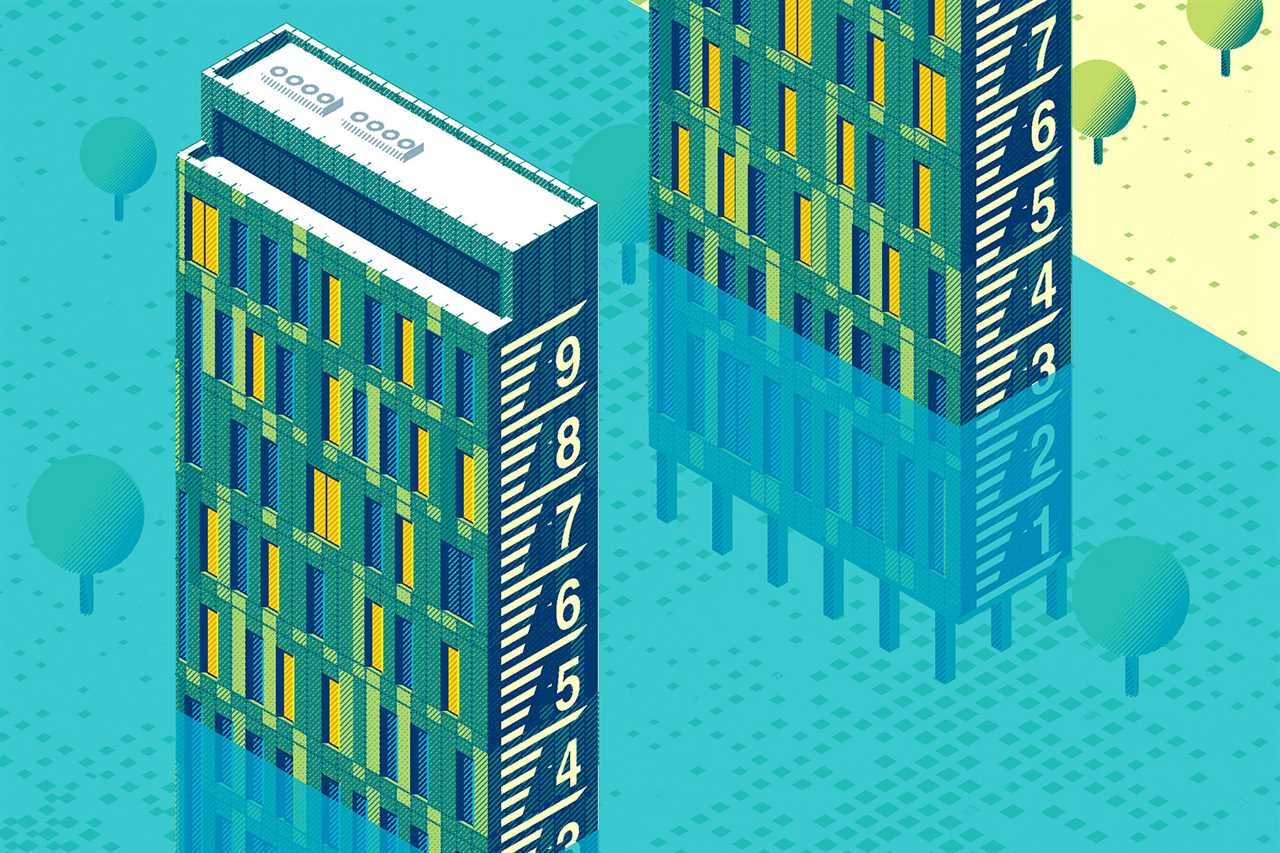
FORT LAUDERDALE, Fla. — It was the kind of extreme weather event that happened all too often this year: On an unseasonably warm day, more than two feet of rain inundated the city, flooding hundreds of cars and buildings, including a recently constructed luxury apartment tower that touts its sustainability credentials to prospective tenants.
Shaped like a massive bow tie, the 18-story Vu New River is gray and white with navy blue accents. Water quickly flooded its palm tree-lined rooftop patio, streamed into upper-floor apartments and coursed down the building's elevator shaft, with some even splashing into the neon-lit lobby.
The deluge shocked tenants who thought the building was fully equipped to handle the changes wrought by global warming. But like a ship that is deemed unsinkable, the Vu New River is one of hundreds of recently constructed structures certified as sustainable that is nonetheless vulnerable to the very forces it seeks to combat.
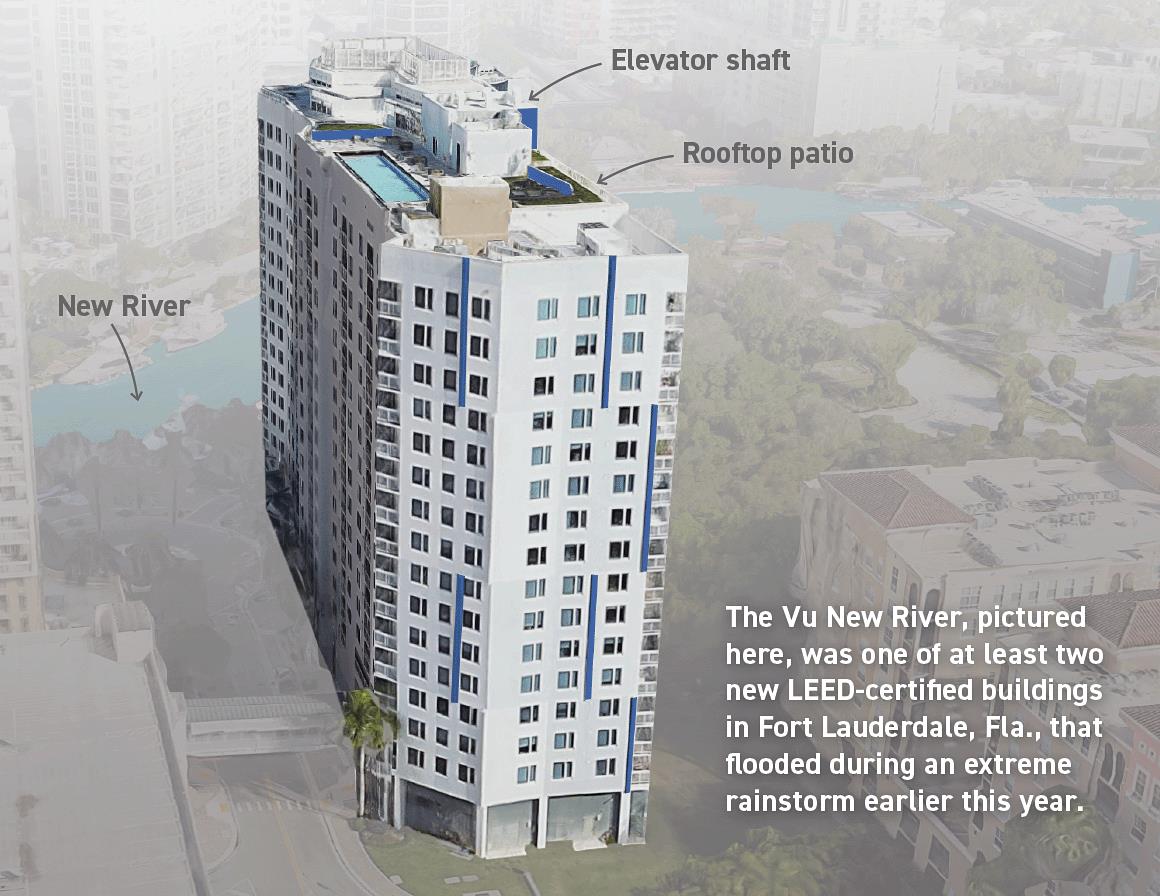
The gleaming tower is one of more than 58,000 construction projects in the United States that have been specially certified as meeting the standards set by the U.S. Green Building Council, a three-decade-old nonprofit that works to make buildings and communities better for the environment and the people who live or work in them.
The main way the Green Building Council does that is via its Leadership in Energy and Environmental Design, or LEED, certification system, which the group describes as "a globally recognized symbol of sustainability achievement." LEED certification is subsidized or required by more than 350 local and state governments as well as the U.S. General Services Administration, which manages the vast federal building stock.
But the influential rating system largely overlooks the growing impacts of climate change, despite increasingly frequent and severe climate-related disasters as well as years of warnings from former Green Building Council officials.
As a result, the Green Building Council has affixed its coveted three-leafed seal to more than 800 new buildings in the past decade that are at extreme risk of flooding, according to an analysis by POLITICO's E&E News and the First Street Foundation, a nonprofit that models likely climate impacts.
That means those "green" buildings have up to a 50 percent chance every year of flood waters reaching at least their lowest point, according to a review First Street did at the request of E&E News. Of that group of structures, historic storm modeling indicates that more than 130 were constructed or overhauled on sites that likely flooded at least once in recent decades.
And anecdotal evidence from Fort Lauderdale suggests those figures could actually understate the magnitude of the problem for LEED buildings, some of the nation's most costly and desirable facilities: The Vu and the Broward County Addiction Recovery Center – another Green Building Council-blessed project in town that was damaged by the April 12 deluge – were not among the 830 LEED buildings that First Street found are most at risk.
First Street's peer-reviewed models are based on open-source government data as well as United Nations-vetted climate projections. Its modeling is relied upon by insurance companies and real estate firms as well as the departments of Treasury, Commerce and other federal agencies.
E&E News discussed the findings with nearly two dozen architects, city planners and policy experts. The analysis, several experts said, suggests that tens of millions of tax dollars have been directed toward new projects that may need to be repeatedly repaired or even abandoned before the end of their expected life span, raising questions about whether some green buildings are truly sustainable.
More importantly, the LEED process and the tax breaks involved could be a crucial tool for preparing man-made structures for climate-related disasters — one that is being squandered today.
"It's a contradiction to call something sustainable if it's also prone to hazards like flood," said Samuel Brody, the director of Texas A&M University's Institute for a Disaster Resilient Texas.
The Green Building Council needs "to better educate developers and tenants on the importance of not just being energy efficient but being resilient to these disturbances like floods," he said. "Because we don't want to put people in harm's way."
The Green Building Council, and the sustainable architecture movement it helped catalyze, emerged in the U.S. in the 1990s amid growing awareness that the burning of fossil fuels could intensify the types of catastrophic impacts the world is now experiencing — from the unprecedented wildfire on Maui to the deadly flooding in Libya.
Originally the group focused on the energy use of buildings, with a goal of maximizing efficiency and minimizing planet-warming carbon emissions. Over the years, the Green Building Council has expanded its focus to include measures intended to create buildings that are also more pleasant for the people in them, such as reducing the use of toxic chemicals and increasing air filtration and circulation.
Over time, these designations have become the gold standard for climate-friendly architecture: States and municipalities offer hundreds of programs to reward developers who agree to follow LEED standards, while renters and buyers look for the designation as a way to satisfy their own desire for a sustainable lifestyle. The rating system can also influence regulators, pushing some to strengthen local building codes.
As such, LEED standards have become a powerful tool in the nation's efforts to reduce climate pollution from the commercial and residential sector, which is tied for the largest source of emissions when factoring in electricity use.
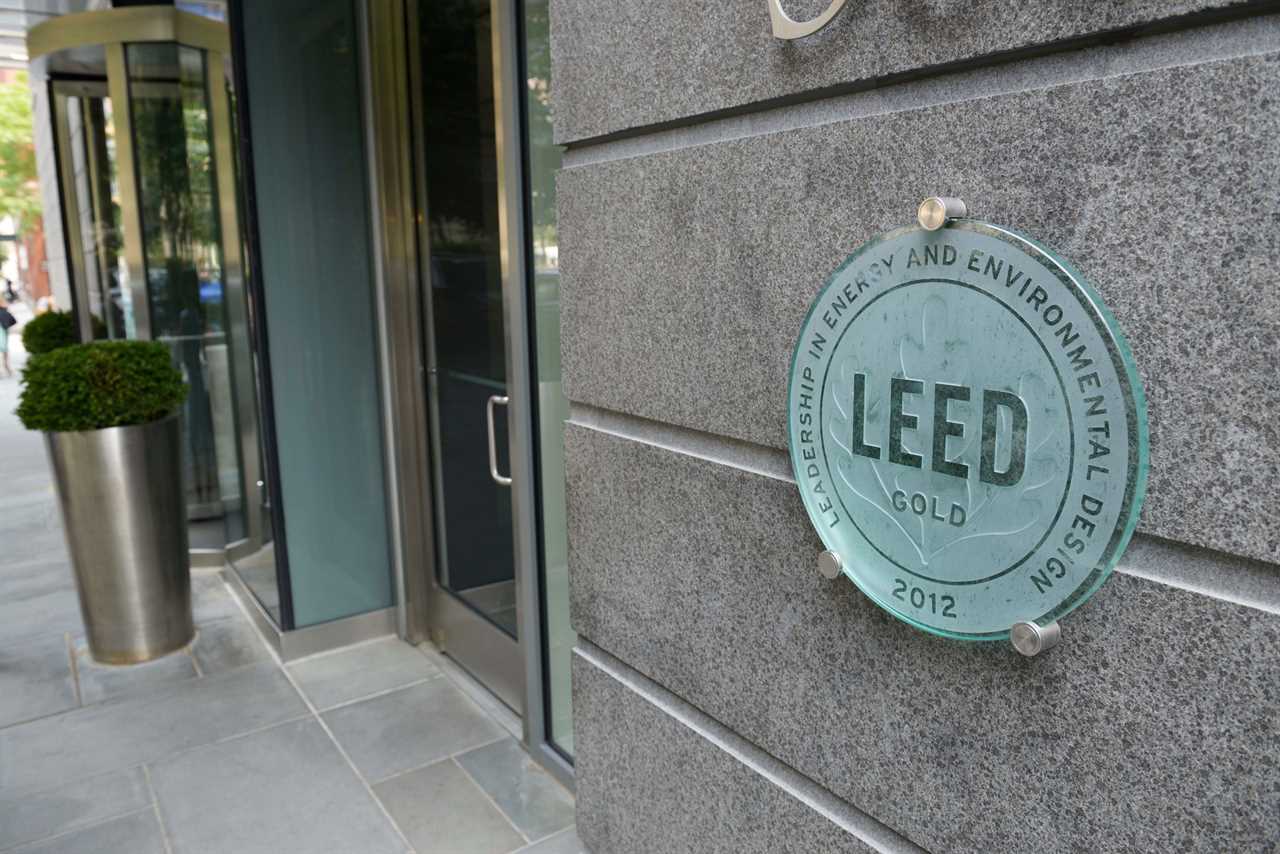
But the Green Building Council has struggled to internalize the lessons from recurring climate-related disasters. From hurricanes Sandy to Maria, those incidents have shown that some new buildings can quickly go from healthy to hazardous if they lose power or water.
Efforts to plan for the potential impacts of major storms have instead been downplayed by the Green Building Council as a distraction for its core sustainability mission, according to some former members, including a past board member.
"Resilience hasn't really been a significant part of the LEED program since its inception," said Alex Wilson, who served on the group's board in 2000 when it publicly launched the ratings system.
"I pushed the council pretty hard to much more actively address resilience," he said. "I've been disappointed that that hasn't happened yet."
The Green Building Council, whose members include many building companies, acknowledged that the LEED system doesn't currently force those developers to consider the growing threats posed by climate change and suggested that modifications could be made when the rules are updated in the next few years.
"We have to look at flooding, we have to look at hazards. I am not disagreeing with you at all on that," said Melissa Baker, a senior vice president at the group.
"But we are balancing it with, where do we put time and points towards energy efficiency, towards carbon," she said of the scorecard-based system. "As adaptation becomes much more present, front of mind — it's obviously critical given what's been going on — we may see that balance shift. And that's something that we're working on now."
Wilson, who has been making the case for resilient design for more than a decade, isn't convinced that the Green Building Council is ready to give the critical issue the attention it deserves.
"I keep hoping I'll see signs of that and haven't yet," he said.
The lack of resiliency standards is especially frustrating, some designers say, because there are a range of things architects and developers can do to prepare for and quickly recover from flooding.
Relatively simple improvements include elevating a building's foundations, designing a "washout" floor that can be easily cleaned and dried after floodwaters recede, and placing vital equipment like electrical and heating, ventilation and air conditioning systems on the second floor. Then there are more challenging measures like installing on-site renewable energy and storage systems or backup water treatment operations that can keep buildings up and running, even when the grid goes down.
But those cautionary steps either cost more upfront or involve some difficult tradeoffs. They are not likely to be taken if project designers and their clients aren't incentivized by local regulators or the LEED system to construct buildings that can withstand the threats posed by an ever hotter and more dangerous world.
"Building codes are boring as hell but they actually matter greatly, in terms of our safety and avoiding loss and damage," said Alice Hill, who during the Obama administration served as the National Security Council's resilience policy chief. "Until we get these codes right, we're going to see a lot more destruction."
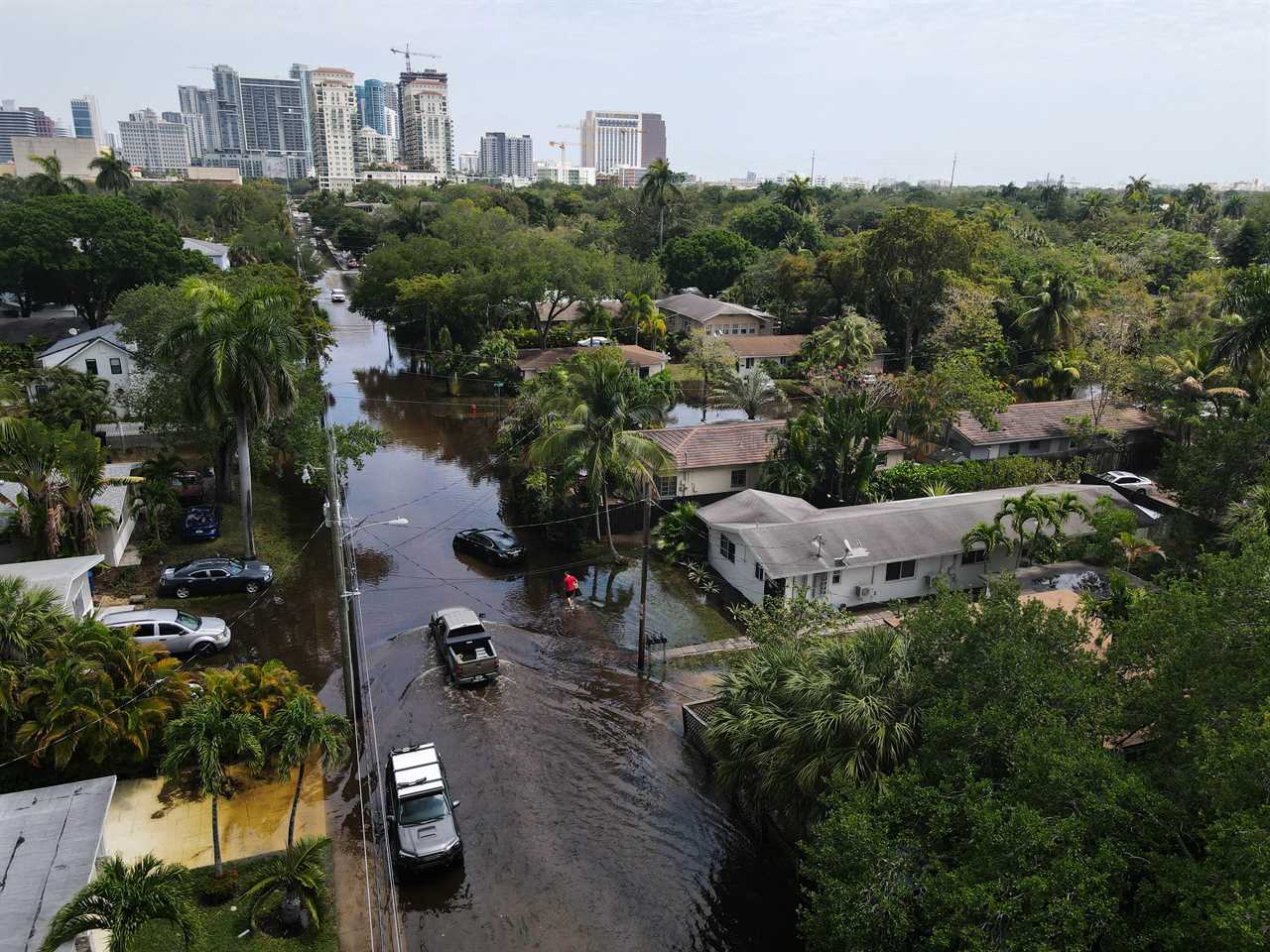
The findings come as the Biden administration, the Green Building Council and other groups are working to make U.S. buildings more resilient.
The White House last year launched an initiative that aims to help state and local governments adopt the latest building codes. Forty states and U.S. territories haven't updated their building codes since 2018, the Federal Emergency Management Agency reported in April.
Meanwhile, the Green Building Council and the International Code Council, an influential nonprofit group that creates model building codes for local governments to use, say they are both working to integrate resiliency features into their offerings.
But LEED standards aren't likely to be updated until 2025, at the soonest. The code council didn't give a clear timeline for its next overhaul.
"If these voluntary organizations establish clear guidance and standards for resiliency, it could reduce loss to the United States. There's no question about it," said Hill, who is now a senior fellow at the Council on Foreign Relations, a centrist think tank. "It's a missed opportunity because we don't have those standards and guidance in place. And so then we construct buildings that are destined to flood or burn."
The LEED rating system began as a pilot project in 1998, five years after the Green Building Council was formed by an environmental lawyer, a real estate developer and a marketing executive at the air conditioning company Carrier. They worked with a scientist at the environmental group Natural Resources Defense Council to develop the ratings system.
The system is based on a scorecard of actions that architects, builders and developers can take to earn points toward certification and hopefully increase the environmental sustainability of their projects. The scorecards and points available vary slightly depending on whether the project is to, for instance, build a hospital, renovate an office or plan a new city.
But nearly all of the new construction scorecards promote actions like sourcing renewable energy from the grid and minimizing water use, as well as including bicycle facilities and creating "quality views" from throughout the building. Some actions, such as the storage and collection of recyclables, are required.
LEED certifications are awarded to projects at four point-based levels: At the top is the Green Building Council's platinum seal, followed by gold and silver. The entry level is simply certified.
It took until 2004 for the industry-led nonprofit group to sign off on its first 100 LEED projects. Last year, the cumulative total topped 100,000, with certified projects on every continent except Antarctica.
Over the decades, the Green Building Council has regularly updated LEED — sometimes to address publicized shortcomings in the program. For example, media outlets repeatedly found that some certified green projects consumed more energy than comparable buildings. Following those reports, the Green Building Council in 2015 required new LEED buildings to provide the group with information on their first few years of energy consumption.
The Green Building Council hasn't taken the same decisive steps to integrate climate adaptation into its sustainability rating system. That's despite a growing realization in the architecture field that building practices need to change in response to the ever-warming world.
The first wakeup call for designers was in 2005 when a Category 3 hurricane — with sustained winds estimated at 120 mph and a storm surge of at least 25 feet high — slammed into southeast Louisiana.
In New Orleans, Hurricane Katrina trapped tens of thousands of people in flooded and powerless homes for weeks while also knocking offline nearly all of the city's health and safety facilities. Amid the sweltering August heat, more than 540 hurricane victims died from acute and chronic illnesses that likely "would have been prevented had emergency and hospital services been undisrupted following the storm," according to a 2014 study by the state of Louisiana.
"Katrina caught everybody's attention," said Douglas Pierce, the resilient design director at Perkins&Will, the world's second-largest architecture firm. The focus of the sustainable design field began "shifting beyond trying to stop climate change to actually having to say, 'climate change is here and we need to deal with it.'"
At the Green Building Council's annual conference that November, Wilson and some 160 other participants — including representatives from in and around New Orleans — put together a policy paper intended to help make the post-Katrina planning and rebuilding efforts more equitable and environmentally sustainable. The recommendations included "shifting development from regions of the city at the highest risk of future flooding" and designing or repairing buildings in other areas "to serve as livable refuges in the event of crisis or breakdown of energy, water, and sewer systems."
"The motivation was one of life saving, not just doing the right thing," said Wilson, who now leads the nonprofit Resilient Design Institute. "So I thought it might be a way — particularly in our politically divided country — to get more people focused on green design and to do so for resilience reasons."
City leaders increased the required base height of new buildings and initially "advocated for turning hard-hit areas into parks and greenspace," said John Lawson II, the press secretary of Mayor LaToya Cantrell. But that plan to bar redevelopment in certain areas prompted pushback from residents because those were mainly historically Black and low-income communities, he said.
"Ultimately, there were no areas of the City where redevelopment was prohibited post-Katrina," Lawson wrote in an email.
The Green Building Council also didn't follow its own advice. The group has struggled to prioritize resilience alongside the other environmental and health considerations woven into the LEED system.
Since 2009, most new building scorecards have only offered up to four points — out of a possible 110 — for considering flooding in site selection, planning for natural disasters or designing for resilience after a disruptive event. And three of those resilience-themed points have only been offered as pilot credits, meaning most LEED experts aren't familiar with them.
The Green Building Council also had a resilience working group for a time. But it went dormant around 2016 when the council began supporting a resilience rating system known as RELi that was initially created by Pierce, the Perkins&Will architect. The system was complicated and few projects adopted it. The Green Building Council effectively gave up on RELi in 2021, shifting management of that resilience standard to a smaller nonprofit.
"What we spoke about — our working group many years ago — was integrating [resilience] throughout all the LEED systems, through all the different credit categories and making this something that was consistently addressed instead of this one-point, throw-away kind of thing," said Mary Ann Lazarus, who along with Wilson co-chaired the committee.
Lazarus has drifted away from the Green Building Council but continues to value and support its work to advance sustainable design.
"I just don't know why this particular issue, which is near and dear to my heart, has been so hard for them to bring into the standard in a really comprehensive way," she added.
As it stands now, the LEED system effectively gives the same priority to setting aside at least a couple of parking spaces for charging electric vehicles as it does to not building on "sensitive" lands like in a floodplain or next to a water body: Each is worth a single point.
The Vu New River earned points for both, even though it is located — as its name suggests — only steps from a yacht-filled estuary that snakes through Fort Lauderdale. That's because the LEED system still rewards projects in flood-prone areas if they are located on "land that has been previously developed," the ratings guide says. The Green Building Council awarded the sleek apartment building with a silver certification in 2015.
The Broward Addiction Recovery Center — the other recently constructed LEED-certified building known to have flooded in the April storm — has a walled-in garden where patients can step out to get fresh air. During the downpour, that space filled up like a bathtub and then overflowed into the ground floor of the residential treatment facility. The county-run drug treatment facility earned a gold certification in 2018. (It scored zero points in a category that encourages steps to limit the quantity of stormwater.)
The Lincoln Property Co., which owns the Vu, didn't respond to questions for this story. Broward County provided photos of the facility but declined a request to tour the building and then didn't respond to follow-up questions.
If the Green Building Council had embedded resilience into its scorecards, those vulnerabilities could have been identified before now, Wilson argued.
"A responsible resilience rating system or overlay to LEED would insist as a prerequisite on doing vulnerability or hazard assessments for any LEED building," he said. "I think places like that would have been flagged and to obtain that LEED certification they should've had to do measures to compensate for vulnerabilities that are identified. But that's not what LEED is set up to do today."
As a result of that shortcoming, some relatively new LEED-certified buildings have already suffered costly repairs. The North Carolina History Center, for instance, received its silver certification in 2012. Five years later, the museum at the mouth of the Trent River had to temporarily close after it incurred extensive damage from Hurricane Florence's 13.5-foot storm surge.
"The center was built to be above historic flood levels," said Nancy Figiel, a spokesperson with the North Carolina Department of Natural and Cultural Resources. The wall of water that accompanied Florence, she noted, was three feet above the previous record high storm surge for the area.
Other new LEED buildings that have been significantly impacted by flooding in the past decade include a library in Kentucky, the headquarters of Vermont's Department of Public Safety and the main offices of oil company ConocoPhillips, whose fuels have helped overheat the planet.
Mark Bosma, a spokesperson for Vermont Emergency Management, said that although the state office complex wasn't damaged by floodwaters this July, it had to be "closed for about a week while the town of Waterbury restored water and sewer [service.]"
Officials from Hazard County, Ky., didn't respond to a request for comment. ConocoPhillips declined to comment.
Most of the flooded buildings identified by E&E News were not "built irresponsibly in remote areas — these are, in many cases, in the heart of our cities and communities," said the Green Building Council's Baker in a follow-up email. "There are hard conversations that need to happen about where and when we rebuild. While those discussions are occurring among community leaders, [the Green Building Council] encourages buildings to incorporate resilience into their planning, development and upgrades."
It's virtually impossible to know the precise number of LEED buildings that have been damaged by floods, wildfires or other climate-related disasters because the Green Building Council doesn't collect that information. Property owners in most states also aren't required to disclose such details to buyers, renters or journalists.
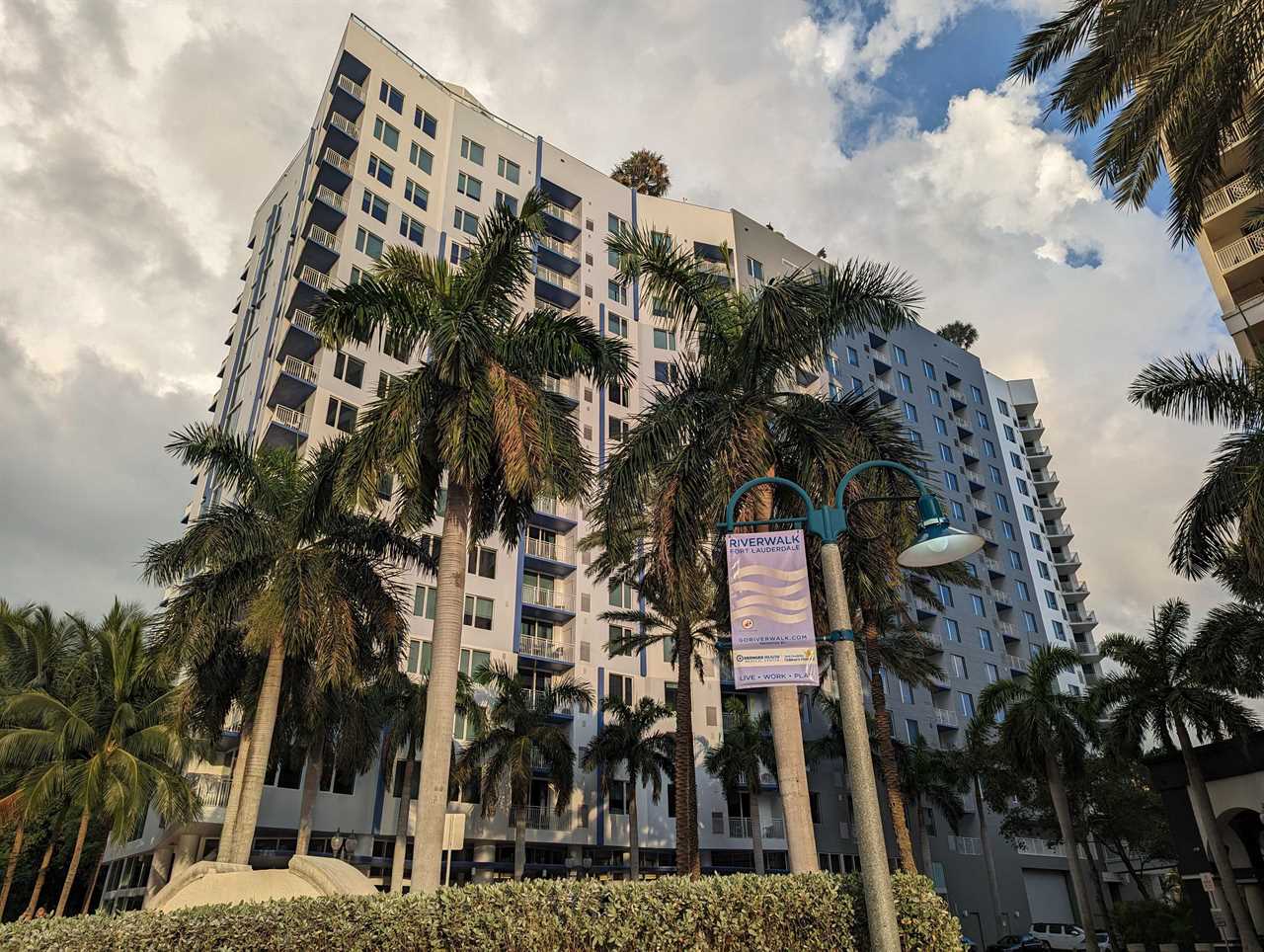
First Street's freely available property-level modeling aims to narrow the information gap. Its analysis of LEED properties suggests nearly 500 new buildings certified by the Green Building Council in the past decade are on sites that have experienced flooding this century.
Those findings don't mean that hundreds of new LEED buildings have been or will be damaged as significantly as the North Carolina History Center, or at all. They do, however, indicate that many of them are in flood-prone areas where design teams should have taken steps to prepare for more rainfall or seawater – ones above and beyond those currently required by the Green Building Council or most local building regulators.
"It is always that balance in a holistic rating system, and in a voluntary scorecard, of where we're putting the points," said Baker.
Back in Fort Lauderdale, a municipal engineer at a May city commission meeting told local leaders they were spending about $40,000 per day to provide backup electricity and cooling for the shuttered city hall building, which is only a few blocks north of the Vu apartments. Day and night, diesel-powered generators the size of shipping containers buzzed outside the angular concrete edifice, preserving the damaged records and property stored inside.
At the marathon meeting, commissioners had a contentious debate about interim office space options, putting off an even longer discussion about how and where to rebuild the heart of the city government. By county law, it will have to be LEED certified.
"I don't think that's going to be a problem," Democratic Mayor Dean Trantalis told E&E News that night. "Because, you know, most buildings these days are very environmentally friendly."
Erin Smith and Sean McMinn contributed reporting.
----------------------------------------
By: Corbin Hiar
Title: ‘A contradiction’: U.S. subsidizes ‘sustainable’ buildings, but leaves them vulnerable to floods
Sourced From: www.politico.com/news/2023/09/25/leed-buildings-climate-floods-00104477
Published Date: Mon, 25 Sep 2023 04:00:00 EST
Did you miss our previous article...
https://consumernewsnetwork.com/politics-us/kari-lake-will-launch-arizona-senate-campaign-next-month






